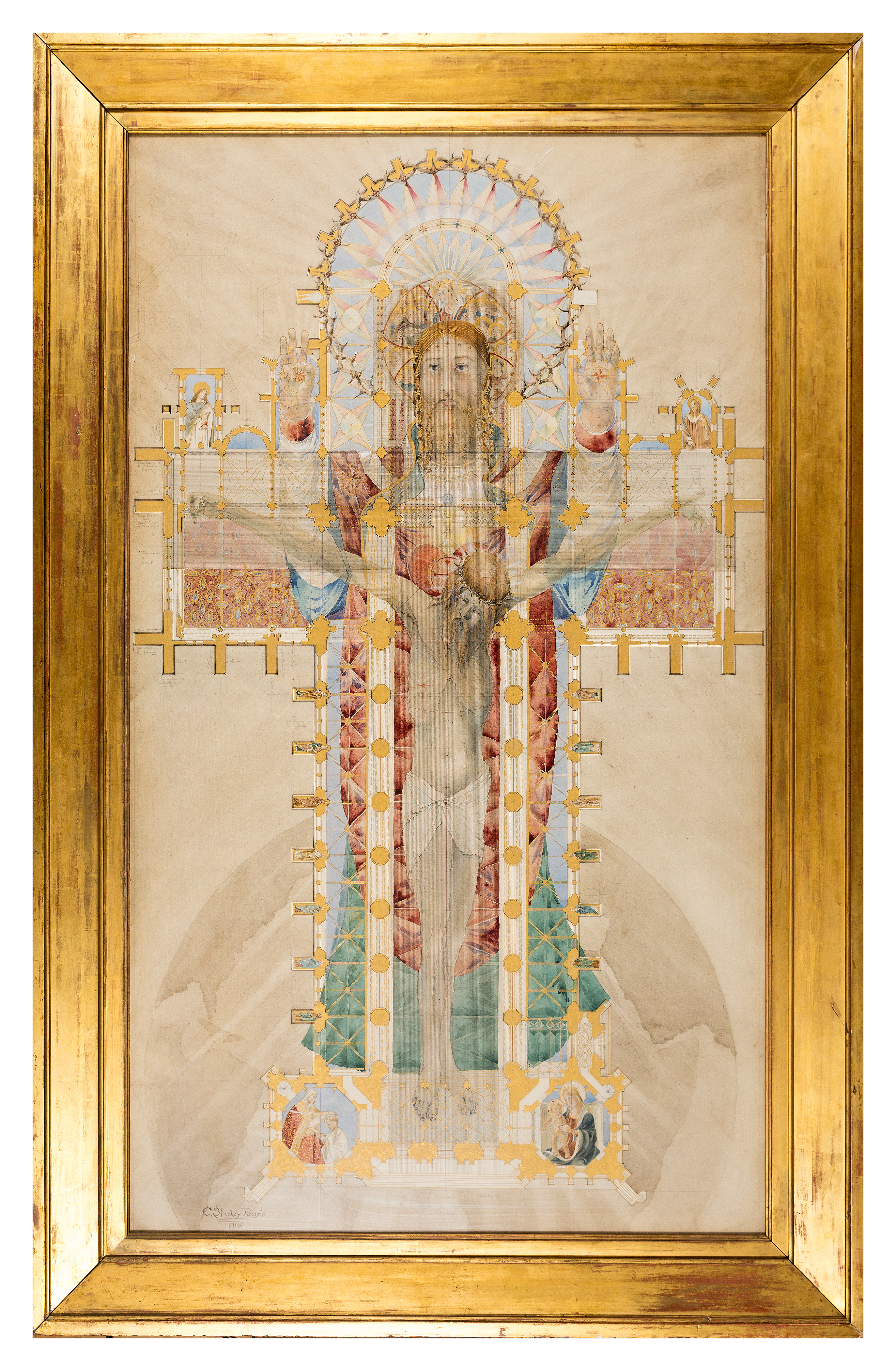C.S. Peach and the Cruciform Design of the Cathedral

In view here is a startling watercolour by Charles Stanley Peach, titled Plan of a Church Constructed on Divine Principles (1910)—his pictorial articulation of the cruciform layout of the Christian Cathedral. Architectural aspects are overlayed upon two images of Jesus. The first with his arms splayed wide, hands pinned to the transepts in indication of his crucifixion; the other, his raised head in the resurrection, adorning the high altar and chapel.
Peach’s Plan of a Church lives from the climatic intertwining of multiple related stories. The first is Peach’s own, as his biography developed through a notable career in designing public utility stations to a cultural-religion obsession. His earlier work is no small feat. He personally travelled to many developing European cities to investigate how the technology of electricity was being distributed.[1] His publication on the topic for the RIBA is exceptional, displaying a great mind keen on a delicate balance between beauty and science. Fittingly, Peach finished his career with a post at St. Paul’s Cathedral.[2]
It is told that while Peach spent his days acting the role of the ‘pioneer of power,’ his nights were consumed with reconstructions of the Temple of Solomon. This interest eventually became a question of its relationship to Christian cathedrals. In an unpublished essay titled The Principles Governing the Design and Constitution of Ecclesiastical Edifices (1910), he presents a theory that effectively replicated the biblical narrative. His argument is that the cathedral is an architectural appropriation of a Jewish theory of ‘symbols,’ merely substituting those of the Israelite prophets for ones derived from the writings of Christ. He concludes that the cruciform shape of cathedrals comes from the synthesis of proportions drawn from the biblical record of Solomon’s Temple with a modified outline of the Tabernacle constructed during the Israelite wanderings between Egypt and Israel.[3]
Several points of Peach’s theory are substantiated by historians of architecture, in their telling of a different dimension of the story. Otto von Simson, for example, explains in The Gothic Cathedral that medieval architects did indeed draw inspiration from the biblical temples. This inspiration included imitations of the ‘splendour’ of these structures,[4] as well as a direct appropriation of their proportions and modules.[5]
The cruciform shape, however, has roots beyond religious symbolism. After adopting the Roman building style of basilica, questions arose on how to preserve a sense of sacrality for the sacraments and clergy. Extensions were added on either side of the central nave to ‘set apart’ these holy elements. It is unclear whether the first variation was the ‘Greek’ cross, where the additions stand at the end of the nave; or the ‘Roman’ cross, where they are added about two-thirds the distance down the nave, as with Peach’s watercolour. In either case, the cruciform plan is more of a historical development in the tradition than an overt application of Christological symbols.
Yet, each of these strands of the narrative are bound together by a theological story. The ‘meaning’ of the two events which are symbolized by Peach is not constrained in the events of Christ themselves. Not that these events do not bear great theological weight in themselves, for these are the events where the world is set to rights. It is that the meaning of Christ accumulates through its history. The history of the church is the story of God’s grace. It augments the shock of God’s death, transforming a corpse into a great hope, an afternoon eclipse into perpetual light. As theologian Eberhard Jüngel exclaims, ‘one cannot estimate highly enough’ that the meaning of these events ‘is maintained only by the fact that it continues to retell that dangerous story of God.’[6] The question of the historical accuracy of these events is not enough to sustain their meaning. For, the meaning of history itself is gathered by our telling of those events. Without our tales, events of the past are forgotten. They become nothing. We make history through story—declaring what the past means for our future.
For Peach, it seems quite evident that his primary concern was on the aesthetics of the synthetic tale; on how to represent its various dimensions in a single form. Even more, the attention to detail by which he made his scholarly mark is also on display in the Plan of a Church. The symbolic relationship is realised through an engineer’s hand. Steady; Certain. Deliberate and determinative. Theologically speaking, the danger of Peach’s watercolour is that the symbolic relation of Jesus’ death and resurrection has become too rational. His imaginative precision moved the image of the invisible God out of its mythological status and into an architectural object. Through his steadying hand, the story of Jesus gains a spatial dimension. In Peach’s chapter, we walk over Christ as we step to worship him. We trample on his glory as we dare to receive his presence.
…
As a theologian, I fear that Peach has made Jesus too real. Then again, perhaps this is precisely the ‘dangerous retelling’ that keeps the story alive.
Notes
- E. Stanely Hall, ‘Charles Stanely Peach,’ Journal of the Royal Institute of British Architects 61 (8 September 1934): 1031.
- Ibid.
- ‘(#238) Charles Stanley Peach 1858-1934,’ accessed October 18, 2023, https://www.sothebys.com/en/auctions/ecatalogue/2006/important-british-drawings-watercolours-and-portrait-miniatures-l06171/lot.238.html.
- Otto von Simson, The Gothic Cathedral. Origins of Gothic Architecture and the Medieval Concept of Order., Third Edition ed. (Princeton, NJ: Princeton University Press, 1988), 11.
- Ibid., 37-8.
- Eberhard Jüngel, God as the Mystery of the World: On the Foundation of the Theology of the Crucified One in the Dispute Between Theism and Atheism, trans. Darell L. Gruder (Grand Rapids: W. B. Eerdmans Pub. Co., 2014; repr., 1983), 312.
C.M. Howell is a PhD candidate in theological aesthetics at the University of St Andrews.
